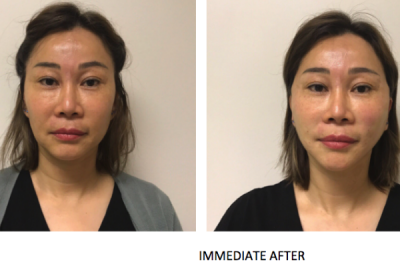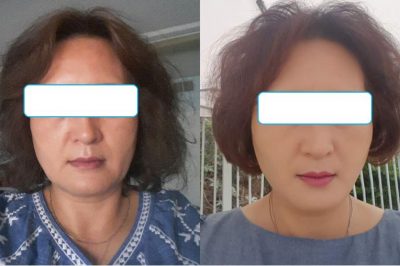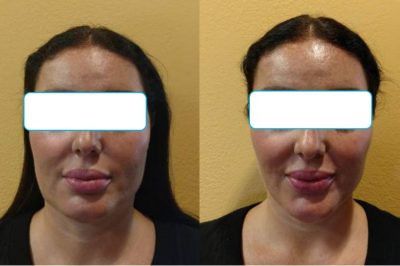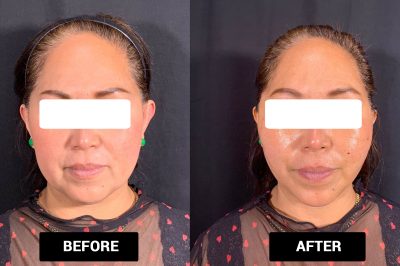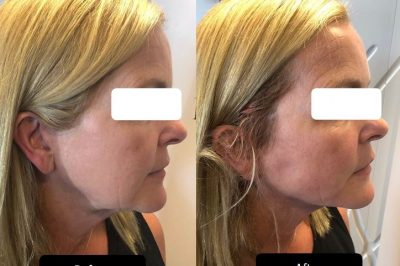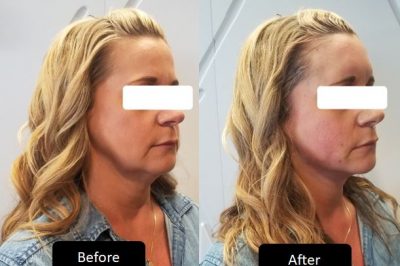Serenity MedSpa is one of the nation’s leading providers of thread lifting. Dr. Lisa Kang, who exclusively performs this procedure at Serenity MedSpa, has trained extensively with top South Korean surgeons specializing in advanced Korean Thread lifting techniques. Dr. Kang is very experienced with the thread lifting procedure and is well versed with the various types of threads and techniques to achieve optimal results that not only last, but also look natural.
What is a Thread Lift?
In a thread lift, threads are inserted underneath the skin to instantly and effectively lift sagging skin. The threads are mainly used on the face and the neck, but can also be used to lift skin on the body.
The thread lifting procedure does not involve surgery. It is a minimally invasive and very safe and effective in-office procedure with little downtime—especially when performed by an experience surgeon.

How have Thread Lifts evolved over the years?
Thread lift is not a new concept. It’s been used in cosmetic surgery for decades internationally, although it is newer to the United States.
The original thread lift procedure started in the late 1990s and was performed up until the mid 2000s. This procedure fell out favor primarily due to the use of permanent threads, which increased the chance of infection and thread breakage. These older, barbed, permanent threads were also difficult to work with and required a more invasive anchoring method into the scalp, temple or brow region to hold up the loose skin. The knots used to anchor these threads had to be tied carefully so that the thread did not release from the anchored site.
Another issue with these permanent threads was that the skin could be only pulled in one direction, which made the results appear two-dimensional. The old thread lifting procedure also required overpulling the skin to get a good result, increasing the downtime, akin to what is now called a mini-facelift. Additionally, these permanent threads made any future surgery in the same area more difficult.
In 2015, Gwyneth Paltrow, actress turned wellness expert, made headlines for covering the older thread lifting procedure on Goop. She called it an “under the radar approach” to anti-aging, despite the fact that it wasn’t considered to be completely safe at the time. Thanks to new research, advancements and FDA approval of newer dissolvable threads, the thread lifting procedure is making a huge comeback.
How is the Thread Lifting procedure of today different that the thread lifting procedure of the past?
The newer thread lifting procedure is radically different from the older one. Because the original threads were made of permanent, nonabsorbable suture materials, once they were placed underneath the skin, they were there to stay – forever. Today’s threads are completely dissolvable, meaning the body naturally breaks them down over time. These absorbable threads are better than the older threads for many reasons:
- They are far safer with very low risk of infection. Bacteria don’t have a permanent foreign material to live on and hide from the body’s immune system. This makes the risk of infection pretty much nonexistent. Permanent sutures, on the other hand, can provide a hideout for bacteria.
- They have far less chance of breakage over time.
- They improve skin quality by stimulating collagen production, making the skin firmer and tighter to enhance the initial lifting results.
- They provide a more natural, three-dimensional look, since they can be lifted in two directions.
What are the advantages of a Thread Lift?
As we age, we lose volume in our face and our skin starts to sag. The result is a longer, more square and older-looking face. While BOTOX® is great for smoothing wrinkles that are formed with movement and dermal fillers are excellent at restoring facial volume and improving deep folds, there was still an unmet need in cosmetic dermatology: a nonsurgical way to effectively lift sagging skin to restore the face’s natural and youthful V-shape and vitality.
Although traditional facelift surgery is an excellent way to address sagging skin, it also carries with it a lot of expense and downtime. Many people are also afraid to “go under the knife” as you may not come out looking natural and liking the results—which, unfortunately, cannot be reversed.
The thread lift is the perfect solution to address sagging skin without surgery that looks natural and is also effective and safe when performed properly. It’s quickly becoming the treatment of choice, especially for busy individuals who need to quickly resume their daily activities.
Summary of the advantages of the Thread Lift
- Instant lifting: People love the instant lift of sagging skin that takes years off the face and neck.
- Natural results: Natural yet noticeable results can be achieved with the thread lift. There’s no worry of looking“ over-pulled” or “wind-blown” as with a surgical face lift.
- Non-Surgical: Since the procedure doesn’t involve any cutting and incisions, it doesn’t leave any permanent scars like traditional facelift surgery.
- Minimal downtime: Because the procedure is far less invasive than a surgical facelift, the downtime is very minimal. Most people are able to return to work soon after the procedure.
- Collagen stimulation: The threads stimulate your own skin to gradually produce more collage in the treatment areas over several months. You not only get the benefit of an instant lift, your skin also gets firmer and tighter over time!
- Cost-effective: Thread lift is a very cost-effective way to achieve a more youthful appearance compared to other aesthetic procedures, like Ultherapy.
- Safety: The thread lift procedure is very safe. In fact, it can be even safer than dermal fillers. Although very rare, dermal fillers have a chance of being injected into blood vessels, which can result in skin necrosis or other major side effects. Since the threads are thin, they don’t have the potential to block blood flow in vessels. Also, since the procedure is done under local anesthetic, it doesn’t carry the risk of general anesthesia used in a traditional surgical facelift.
What types of absorbable threads are available in the United States?
Two main types of absorbable threads are used in the United States today. These are the PDO (Polydioxanone) and PLGA/PLLA (poly lactic-co-glycolic acid) threads. Both PDO and PLGA have been used safely for many decades in different surgical specialties.
In the United States, the NovaThreads (PDO threads) and the Silhouette Instalift (PLGA threads), a.k.a Silhouette Soft in Europe are the most popular. These threads have brought the thread lifting procedure back into the spotlight. The MINT PDO threads are also FDA approved and are one of the preferred PDO threads, as it is a stronger thread.
What is the PDO (Polydioxanone) material that’s used to make the threads?
PDO is a synthetic polymer (a type of sugar molecule) that is colorless and crystalline. It’s been used in biomedical and pharmaceutical applications (such as rods, screws and pins in orthopedics and sutures for heart and eye surgery) for many years because of its extremely safe profile. This material has excellent biocompatibility (e.g. it’s non-allergic and non-antigenic) and is also completely biodegradable and doesn’t create scar tissue. Since the body completely absorbs the PDO material, possible complications are significantly reduced.
What are the various types of PDO threads and how are they are used in thread lifting?
As the thread lifting procedures become increasing popular, there are more and more offices that are starting to offer this treatment. However, it can be challenging for consumers, and even doctors, to figure out what types of threads and procedures are best. PDO threads come in varies sizes, shapes and thicknesses. Knowing how to use them correctly and effectively comes with years of experience, skill and knowledge. Although procedures using PDO threads can seem simple, they require advanced skills to use them effectively and safely.
There are two main categories of PDO threads: non-barbed and barbed:
PDO thread categories
| Non-Barbed | Barbed |
| Mono-filament (smooth) threads | Unilateral vs bilateral |
| Braided (twist, screw) threads | Uni-directions vs bi-directional vs z-type |
| Cutting barbs vs molding barbs |
Non-Barbed PDO Threads – Collagen Stimulation (Smooth or Braided)
These “non-barbed” threads come in two main forms: smooth (mono-filament) and braided (twist, screw).
The smooth threads are usually single, very thin threads (i.e. the diameter of your hair). The braided threads come in one or more threads that are intertwined in a helical fashion around the inserting needle. These threads are typically very short, usually 1” or 1.5”.

These threads are mainly used for collagen production and are inserted into fine lines and wrinkles. Some immediate effect can be seen after the insertion of these threads. However, since it takes time to build collagen, more noticeable results will be seen few weeks later, with continued improvements over the next 3-6 months. For even better results, more of these non-barbed threads can be inserted a few months later to continue to stimulate collagen production.
These threads are best used in conjunction with BOTOX® and dermal fillers (such as Juvederm® and Restylane®) to help soften forehead and neck lines, lift up sagging eyebrows and upper eyelids, tighten loose skin under the eyes, lighten dark circles, soften vertical cheek and smile lines and soften upper lip and neck lines. Some techniques utilize numerous threads inserted right underneath the skin to give a “lifting” effect. However, the lift that is achieved with this technique is minimal and doesn’t last as long as the lifting that’s achieved with thicker barbed threads.
Usually around 10 – 20 smooth threads are inserted right underneath the skin in a “mesh” (criss-cross) pattern to help with fine lines and to firm up the skin through collagen production. The braided threads can give a little bit more volume than the smooth threads. Hence, they can be used for deeper wrinkles and lines and are also good for defining lip borders.
Barbed (Cog) PDO Threads – Lifting
Barbed (or cog) threads are thicker mono threads with barbs on the threads. These barbs hook and hold the tissue underneath the skin. When these barbed threads are inserted, the barbs open up like an umbrella to form a support structure that lifts and repositions the sagging tissue.
Depending on how they are inserted, these threads can give different results. Many U.S. providers insert them in a “floating” fashion, which means these threads are not anchored anywhere in the skin. This is an easier insertion method. Consequently, people can quickly become disappointed with the minimal lifting effect that may last only several months.
A more effective way to insert these barbed threads is by using the “anchoring” technique. This provides more significant lifting and also sustains the lift for a longer period of time. South Korean doctors have mastered this advanced technique, and it is what Dr. Lisa Kang practices at Serenity MedSpa. This advanced “anchoring” procedure is highly technical and must be performed well to achieve excellent results and minimize potential side effects.
What is MINT and what are the advantages over other PDO threads?


A successful outcome of a thread lift procedure depends both on excellent technique and the type of suture used. MINT (Minimal Invasive Nonsurgical Thread) PDO threads, with their stronger lifting power compared to other PDO threads, is the material of choice.
The MINT PDO threads were designed to most effectively perform a nonsurgical facelift by lifting up sagging skin to restore a more youthful V-shape.

WHY MINT PDO
MINT PDO threads are the latest innovation from South Korea. They have several distinct advantages over other threads. MINT PDO is a heavy gauge barbed thread. The heavier gauge and patented barbs allow the threads to give more lifting and lasting hold than weaker threads. Like all PDO threads, it also promotes collagen in the treated areas and dissolves 6-9 month after insertion, with lifting effects lasting for at least one year or more.
Patented Molded Barbs
The barbs on the MINT PDO threads are machine molded through a patented process, rather than cut into the threads, which weakens them. Hence, these barbs achieve a stronger hold on the tissues to give better results.

Unique 360˚ design
MINT PDO threads have molded barbs around the threads in a unique 360-degree pattern. This design enables the molded barbs to hold the tissues from all directions. This further contributes to their strength and long-lasting lifting power.
Bi-directional Helically Positioned Barbs
The barbs on the MINT PDO threads are also bi-directional and helically positioned to further contribute to the strong anchor on the soft tissue to sustain the lift.
Anchoring Strength and Tensile Property
MINT PDO threads are superior to other PDO threads, as the patented molded barbs will retain their anchoring strength on the tissue, providing a longer-lasting result.

MINT has a diameter of 0.400 – 0.499mm, which is USP size 1-0 for a stronger tensile strength. Bi-direction and helically positioned barbs on the MINT strongly anchors onto the tissue and gathers, then approximates to the desired position.


Are MINT PDO Threads FDA approved?
Yes. MINT PDO threads have received its 510(k) clearance from the FDA and are currently being used in many other countries worldwide. MINT PDO threads are manufactured in Hans Biomed’s research facility in South Korea and shipped all over the world. They are currently used in more than 15 countries worldwide, including in Asia, Latin America and the Middle East.

Which areas can be treated with the MINT PDO thread lift procedure?
Mint PDO thread lift is very versatile and can be used for many areas on the face and neck. The main areas that are lifted include:
- Eyebrows
- Nasolabial fold and smile lines (mid-face)
- Jowls and jawline (lower face)
- Marionette lines
- Chin and neck
Who are good candidates for the MINT PDO Thread lift?
Thread lifting is an ideal solution for both men and women with mild to moderate skin laxity and sagging skin in the face and neck. The best candidates for thread lifting are men and women 30-60+ with relatively good skin tone. Thread lifting is a great alternative for men and women who don’t wish to undergo traditional face lift surgery with its long downtime, expense and potential complications, but still want to look refreshed and lifted, naturally. It’s also an excellent choice for those who just want to lift their skin and not get too much volume, as with fillers. Also, it’s a great choice for those who need more than just skin tightening that is achieved with aesthetic skin tightening devices.
What are the contraindications for the MINT PDO Thread lift?
- Thread lifting is not performed on women who are pregnant or breast-feeding.
- Thread lifting should not be performed on those with active skin infection or inflammation.
- Patients with blood clotting disorders are not good candidate for thread lifting.
How do I prepare for the MINT PDO Thread lift?
Before your procedure, to minimize bruising from the procedure, please stop all blood thinners for at least 10 days (e.g. fish oil, aspirin, ibuprofen, Vitamin E, turmeric, etc.). If you are taking blood thinners for medical conditions, please inform us before the procedure.
How is the MINT PDO Thread Lift procedure performed?
-
- The treatment area is thoroughly cleaned.
- Photos are taken.
- A strong topical numbing cream is applied.
- Oral pain analgesia (e.g. Tylenol or Vicodin) is given before the procedure, if desired.
- The topical numbing cream is removed after 30 minutes and treatment area is thoroughly cleansed and prepped.
- The doctor marks the treatment area with the thread lift design to optimize the results.
- Local anesthetic (Lidocaine) is injected into all the areas where the threads will be placed. This is to ensure the patient doesn’t feel any pain during the thread insertions.
- The threads are inserted underneath the skin in the predetermined areas.
- Once all the threads are inserted, the patient sits upright to check the results and adjust the threads as needed.
- Excess threads are cut off.
- Arnica patchs and ice packs are applied to minimize any bruising.
- Post-procedure instructions are given to the patient.
MINT VIDEOS
https://youtu.be/gPHNHDyHHnc
https://youtu.be/Dys4wuMYUCs
How long does the MINT PDO thread lift procedure take?
Depending on the areas treated, it takes about 20-30 minutes to insert the threads. However, the patient will be at the office for about two hours, which includes the prep, numbing and post care.
Is the MINT PDO thread lift procedure painful?
You may feel some slight stinging during the lidocaine injection. However, once all the lidocaine injections are complete, you shouldn’t feel pain from the threads.
Right after the threads are placed, you will feel some tightness in the treatment areas. You may have some soreness for several days to couple weeks, depending on the number and location of threads. Oral analgesic can be prescribed as needed for post-op comfort.
What will I look like right after the PDO Thread lift procedure? What is the recovery after a PDO Thread lift procedure?
You will see immediate lifting of the loose skin right after the procedure. Due to the lidocaine injections, you will have some swelling. Most of the swelling should resolve in few days. There may be some mild bruising that lasts a few days to a week. We provide arnica patches (Cearna) that significantly minimize any potential bruising. You’re able to wear make-up the next day.
Patients are able to resume their normal daily routine right after the procedure.
Since the threads are absorbable, no sutures need to be removed after the thread lifting procedure.
Below is a before-and-after photo (immediately after the procedure) of an actual client performed by Dr. Lisa Kang. She has swelling from the lidocaine injections, especially in the mid-face, but you can still appreciate the immediate lift that is achieved.

Will I look “unnatural” or like a different person after my MINT PDO Thread lift?
The short answer is “no.” The purpose of the thread lift is to lift loose and sagging skin. This will give you back a more youthful and vibrant look. The thread lift can look more natural than filler injections or a traditional facelift by restoring a sharper jawline and V-line. The results also greatly depend on the experience and the technique of the provider performing the procedure.
What kind of results can I expect after the MINT PDO Thread lift?
The great thing about thread lifting is that you can immediately see natural-looking lifting results. They will continue to improve over time as the swelling is resolved and your body starts to regenerate more collagen for the next 3-6 months.
The rejuvenated skin will start to be more noticeable after 1-2 months. The skin texture will be firmed and smoother. This is essentially a 2-in-1 lifting and firming procedure.
BEFORE AND AFTER PHOTOS
What is the MINT PDO thread lift aftercare?
It’s important to avoid big facial expressions (big smiles and yawns) and excessive neck movements after the procedure for about 2 weeks to minimize stress on the lift until the threads are more incorporated into the tissue.
Other after-care instructions include:
- Keep your face (and/or neck) clean right after the procedure and don’t wear makeup. You may wash your face the next day and use make-up, if needed.
- Try to sleep face-up and elevated on pillows for the next 3 days to minimize swelling and pressure on the treatment areas.
- Avoid rubbing the face aggressively when washing, shaving and drying for the next 5 days. Be gentle and don’t push too hard in your treatment areas.
- Avoid high impact sports (such as running), strenuous exercise or heavy lifting for 1-2 weeks, as they may create too much facial and neck movement.
- Don’t use saunas for at least 2 weeks.
- Avoid dental procedures for two weeks that will require you to open your mouth widely.
- Avoid facedown massages and skin treatments (such as radiofrequency) for 4 weeks.
- Periodically ice the treatment area for the next 2 days to minimize swelling and discomfort.
- Arnica patches are recommended to use immediately after the procedure to minimize bruising. (This is provided at our office). You can also take Arnica tablets before and after the thread lifting procedure and use topical arnica ointments after the procedure.
- Tylenol can be taken as needed for relief of post-procedure discomfort. Our physician can also prescribe Vicodin, if desired.
How long does the MINT PDO Thread lift result last?
The MINT PDO threads will fully dissolve in 6-9 months. During that time, new collagen will also form in the treatment areas, making the results of the threads last for a year or longer, depending on the patient’s skin condition and age. The thread lift’s lasting power depends on the age of the patient and how much sagging was corrected.
To further enhance and extend the results of your initial thread lift, additional “booster” threads can be inserted at a later time. The results of the thread lifting can also be prolonged with other skin tightening treatments, such as the VZet (HIFU, high-intensity focused ultrasound), Ulthera or RF Microneedling (Secret RF). The thread lift procedure can be repeated in the same or other areas of your face, neck and even body as many times as desired to maintain and provide further results.
Is MINT PDO thread lift safe? What are the side effects?
The MINT PDO thread lift procedure is very safe with no serious side effects. In fact, thread lifts can be safer than fillers (although very rare, fillers can potentially cause skin necrosis if it gets into a vessel and is not dissolved). Mild bruising, swelling and tenderness are expected after the procedure, which will resolve within a few days to couple weeks.
Other potential, but very rare, side effects that are easily managed include:
- Infection
- Potential slight asymmetry
- Migration or protrusion of threads
- Prolonged skin puckering or depression
With the new absorbable threads, many of the potential side effects seen with the older, permanent threads, such as thread breakage, are very rare.
To avoid unnecessary side effects, make sure you have this advanced procedure performed by an experienced and qualified professional.
Who performed the MINT PDO thread lift at Serenity MedSpa?
It‘s very important to choose an experienced, skilled provider, especially when it comes to a highly advanced, technical procedure like the thread lift. The type of threads, thread design, technique and provider experience plays an important role in your results. The threads also need to be precisely placed at the correct depth beneath the skin to provide optimal lifting and to avoid potential side effects (like dimpling and puckering). Thread lifting can be a relatively simple, safe and effective procedure in the hands of a well-trained and experienced surgeon. However, in the hands of a novice, you can end up with a disappointing and unnatural results and troublesome side effects.
It’s important that you choose a specialist who is extremely knowledgeable in advanced thread lifting techniques with years of experience in aesthetic procedures. They should also have a trained artistic eye to create a customized lift that preserves your youthful shape. At Serenity MedSpa, Dr. Lisa Kang, with her surgical background and extensive experience with technically advanced procedures, will personally perform your thread lift. Dr. Kang is one of the first providers to offer the new thread lifting procedure with absorbable threads in the United States. She has performed many PDO thread lifts, as well as the Silhouette Instalift. She continues to refine her thread lifting techniques and frequently attends conferences and advanced trainings.
Because everyone’s face is different, Dr. Kang will discuss your aesthetic goals and create a customized treatment plan during your initial consultation. We have many highly satisfied clients that love the natural lifting achieved with our thread lifting procedure.
How much does the MINT PDO thread lift cost?
The price of the MINT PDO thread lift depends on how many threads are needed to achieve your desired results and what areas you wish to treat. Dr. Kang will discuss this with you during your initial consultation.
What are the differences between MINT PDO threads and Silhouette Instalift®?
Both of these threads are excellent and are used very frequently at Serenity MedSpa. At times, Dr. Lisa Kang will use a combination of the two threads to achieve optimal results. Dr. Kang will determine which threads are best to meet your needs.
The differences are outlined below:
Materials: Silhouette Instalift threads are made out of PLGA (ploy lactic-co-glycolic acid) and the MINT Threads are made out of PDO (Polydioxanone).
Asorption time: MINT PDO threads will dissolve after 6-9 months, depending on the thickness of the thread. Silhouette Instalift threads will dissolve in about 1 year. Both threads will stimulate collagen production once inserted under the skin.
Shape: MINT PDO threads have 360˚molded barbs on the threads that grab onto tissue for lifting. Silhouette Instalift threads have a patented 360˚ cone action.
Lifting Power: MINT PDO and the Silhouette Instalift threads both provide excellent lifting. In general, MINT PDO is used on younger skin and people with heavier jowls. Silhouette Instalift is preferable for thinner skin.
Duration: In general, MINT PDO thread lifting can last at least a year or longer. Silhouette Instalift results can last around 2 years. However, the durability will depend on how much lifting was achieved, the age of the patient, the patient’s skin quality and how the skin is maintained after the procedure.
Cost: MINT PDO thread lifting is slightly less expensive than the Silhouette Instalift due to the cost of the threads.
What are some other applications for different types of threads used at Serenity MedSpa?
Nose Threads
There are specific Korean PDO threads that are made for the nose. These threads can be used alone or in conjunction with hyaluronic acid fillers like Juvederm® Voluma. If you have a flatter bridge and need more significant lifting, fillers can be used to give more volume, followed by nose threads to give it more definition and to raise the tip of the nose. Since hyaluronic acid fillers are “softer,” it’s difficult to create a more defined nose tip. The nose PDO threads, however, are excellent at creating a sharper, more raised nose tip. The Korean PDO nose threads can also be used alone if significant volume is not needed.
This is a quick out-patient procedure with minimal downtime that gives instant results. With the combination of a hyaluronic acid filler and nose PDO threads, you can get an instant “non-surgical nose job.”
PLLA (Poly Lactic Acid) Undereye Threads
Absorbable Korean PLLA threads are made specifically for delicate under eye skin. These threads improve dark circles, help tighten loose under-eye skin and improve fine lines.
Made out of 75 fine PLLA threads in a mesh form, they open up once inserted under the skin. The thickness of one PLLA thread is less than the diameter of a hair. Two threads are usually inserted under each eye and will continue to stimulate collagen production to improve under-eye skin.
These threads work well with hyaluronic acid fillers, such as Juvederm® Volbella. Juvederm® Volbella is injected into the tear troughs with a cannula to minimize bruising, which instantly improves hollows and dark circles. The PLLA threads are then injected underneath the skin under the eyes to further lighten dark circles and tighten the lower eyelids. Over the next few months, the under eye area will continue to improve as collagen remodeling takes place. This quick treatment usually does not have any downtime.
Eyebrow Threads
Various PDO threads can be used to gently lift the corners of the eyebrow to give them a more youthful arch and to lift up sagging upper eyelids. Small braided threads can be used, as well as small threads with tiny barbs if more lifting is desired.
This quick procedure has minimal downtime and gives some instant lifting results, which will continue to improve over the next few months. More threads can be inserted 3-4 months later to enhance and extend the results.
Threads for Body Lifting and Firming
Various combinations of smooth and barbed PDO threads can be used to lift and firm loose body skin. Popular areas are the upper arms, abdomen, thighs and above the knees.
What are the advantages of the MINT PDO thread lift over skin tightening treatments like Ulthera®, Secret RF® Microneedling or Thermage®?
Compared to non-invasive skin tightening treatments, thread lift will give you instant lifting that cannot be achieve with skin tightening treatments. So, if you desire a stronger lifting effect, the thread lift is a far better choice over skin tightening. However, for optimal results, skin-tightening treatments are recommended after the thread lift to tighten the skin overall and further enhance the results.
What are the differences between the thread lift procedure compared to the traditional facelift and neck lift?
Although the traditional face lift is an excellent way to address sagging skin, it also carries with it a lot of expense and downtime. Also, many people are afraid to “go under the knife” as the results may not look natural– which, unfortunately, cannot be reversed. Thread lift is an excellent alternative as it is a far safer, less invasive way to address sagging skin.
Here is a summary of the differences between the thread lift and the traditional surgical facelift:
- Invasiveness: Unlike the traditional surgical facelift, the thread lift doesn’t involve any incisions, cutting or “deep tissue manipulation.” Hence, it’s a much easier process for the patient (similar to getting fillers) with minimal downtime of a few days versus one month for a facelift.
- Scar: Thread lifting doesn’t leave any scarring. A traditional surgical face lift will leave permanent scars.
- Cost: Thread lifting is a fraction of the cost, compared to the traditional surgical facelift.
- Side effects: Thread lifting has far less potential side effects as it requires only local anesthetic to perform the procedure versus a general anesthetic for the surgical facelift. Also, any potential side effects from the thread lifting are usually minor and temporary, versus surgical facelift side effects, which can be major and permanent.
- Results: Thread lifting is not meant to replace the tradition surgical facelift in terms of the magnitude of the lifting. However, the thread lifting procedure is still able to give significant and effective lifting using the advanced Korean Thread lift techniques. Furthermore, there is minimal risk of looking unnatural with the thread lift when performed correctly, versus the potential “overdone” or “wind-blown” look that can happen with the traditional surgical facelift.
- Longevity: Although the thread lift may not provide as dramatic a lift as the traditional facelift, thread lifts provide a more “natural” look and an effective “lift” that can last for 1-2 years.
How is the thread lift result different than dermal fillers, such as Juvederm® or Restylane®?
Dermal fillers, such as Juvederm® and Restylane® are great products if you have volume loss under the eyes or in the cheeks. Dermal fillers are a quick and effective way to improve the nasolabial folds and marionette lines. However, if you also have mild to moderate sagging skin, especially in the jowl area and neck, thread lifting is a far more effective and natural way to achieve a youthful look than dermal fillers. Too much filler in the lower face can actually make you look more “square” and “heavy.” Thread lifts, on the other hand, will lift up the jowls to restore that beautiful, youthful V-shape, instantly.
To achieve optimal results, the two treatments are complimentary. The results can also last longer when thread lifting is combined with dermal fillers. Usually, it’s recommended to perform the thread lifting procedure first and then add dermal fillers if needed to address volume loss. However, once you lift up the sagging skin with the threads, less fillers will be required as the thread lift treatment will correct a lot of the nasolabial folds and the marionette lines – in a far more natural way.
During the initial consultation, Dr. Kang will create a customized a treatment plan to meet your desired aesthetic goals using a combination of treatments, such as thread lifting, dermal fillers, BOTOX® and skin tightening that will result in a far more natural and youthful look than simply using BOTOX or dermal fillers alone.
To learn if you’re a good candidate for the MINT PDO thread lift, schedule a complementary consultation with Dr. Lisa Kang.
For San Francisco, North Bay and East Bay clients, please call our SF office at (415) 781-9200 or email Info@SerenityMedSpa.com.
For Peninsula and South Bay clients, please call (650) 887-7777 or email Burlingame@SerenityMedSpa.com.

